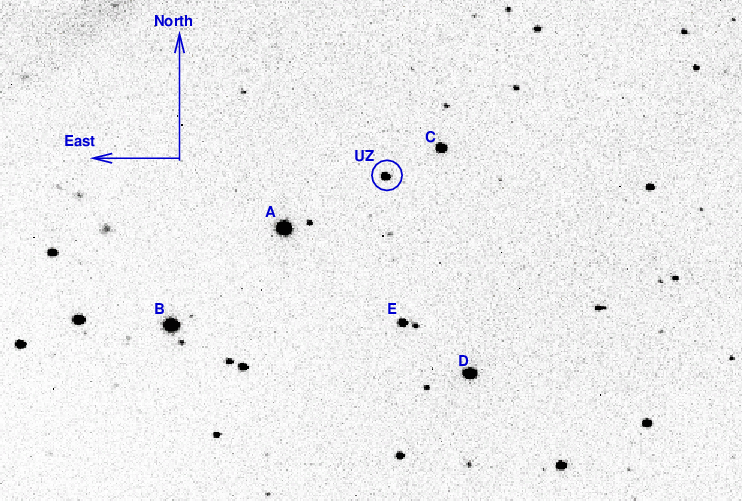
On the night of Aug 28/29, 2013, I observed UZ Boo and SN 2013ej in M74. Conditions were fair -- the skies were clear, and there was no moon, BUT it was very humid. There was almost a fog at ground level.
The main setup was:
Notes from the night
I took a series of images of UZ Boo, using a 150-second exposure time.

The zero-point offset graph shows mostly a steady rise as UZ Boo slowly sets.
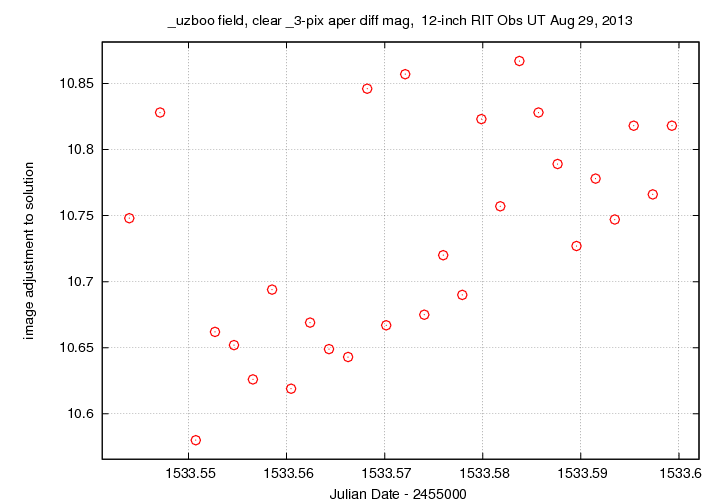
I measured UZ Boo and many other stars in the field, using an aperture 3 pixels (5.6 arcsec) in radius. Since I used a clear filter, the bright stars "A", "B" and "D" were saturated, and were not included in the ensemble solution. I used the star "E" = UCAC4 561-055129 = AAVSO 000-BBV-649 to shift the instrumental magnitudes to the standard scale. These measurements are made with a "clear" filter, but I'll shift them to match the V-band scale: 000-BBV-649 has mag V = 14.267 according to the AAVSO chart 12447AMF.
Below are light curves for UZ Boo and several of the unsaturated stars in the field.
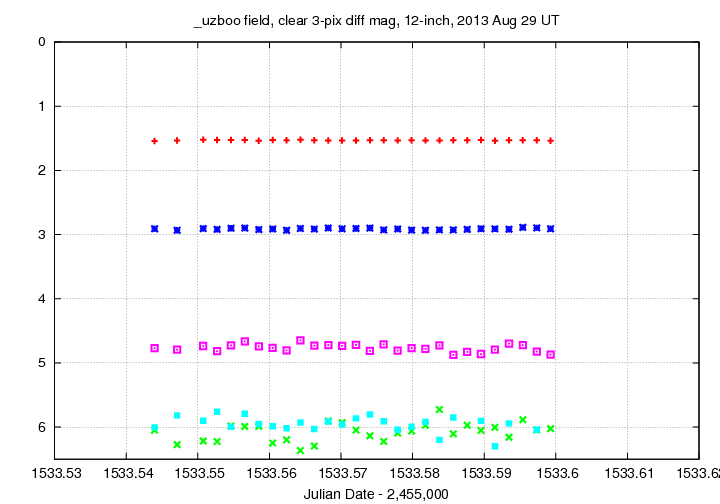
Here's a closeup of UZ Boo and stars of similar faintness. The noise is very large, so that it very likely swamps any instrinsic variation in UZ Boo.
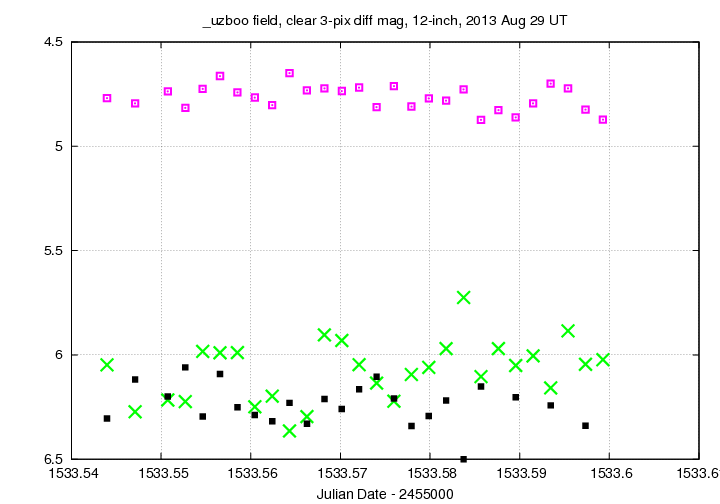
The variable star has entered a phase in its evolution in which it fades by about 2 mag, then rebrightens, then fades again, then rebrightens, etc. My measurements at the RIT Observatory catch UZ Boo at several places in this complicated evolution; tonight, it was so faint that I think it's heading back to quiescence.
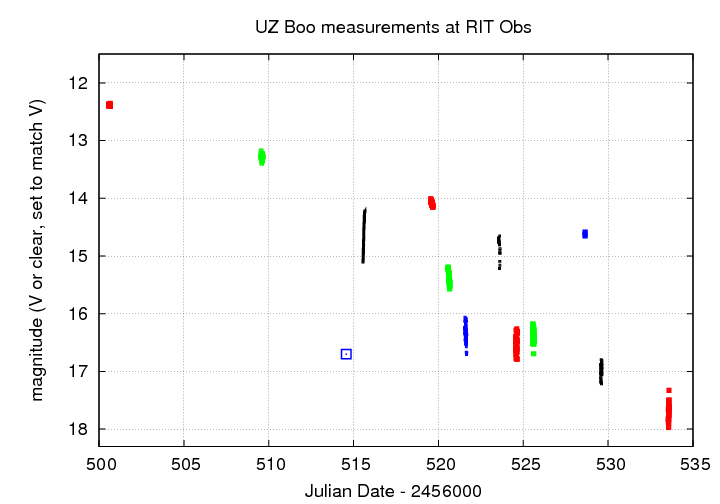
Below are the first few lines of the report I've sent to the AAVSO and VSNet.
# Measurements of UZ_Boo made at RIT Obs, Aug 29, 2013 UT, # in fair conditions, # by Michael Richmond, using 12-inch Meade and SBIG ST-8E CCD. # Exposures 150 seconds long, clear filter. # Tabulated times are midexposure (FITS header time - half exposure length) # and accurate only to +/- 1 second (??). # 'mag' is a differential magnitude based on ensemble photometry # using a circular aperture of radius 5.6 arcseconds. # which has been shifted so UCAC4 561-055129 has mag=14.267 # which is its V-band magnitude according to AAVSO. # # UT_day JD HJD mag uncert Aug29.04397 2456533.54397 2456533.54123 17.653 0.164 Aug29.04711 2456533.54711 2456533.54437 17.878 0.169 Aug29.05075 2456533.55075 2456533.54801 17.821 0.159
SN 2013ej is a Type II supernova in the relatively nearby galaxy M74. It was discovered by the KAIT group about one week before maximum light. Here's a chart showing the galaxy, the SN, and some reference stars:
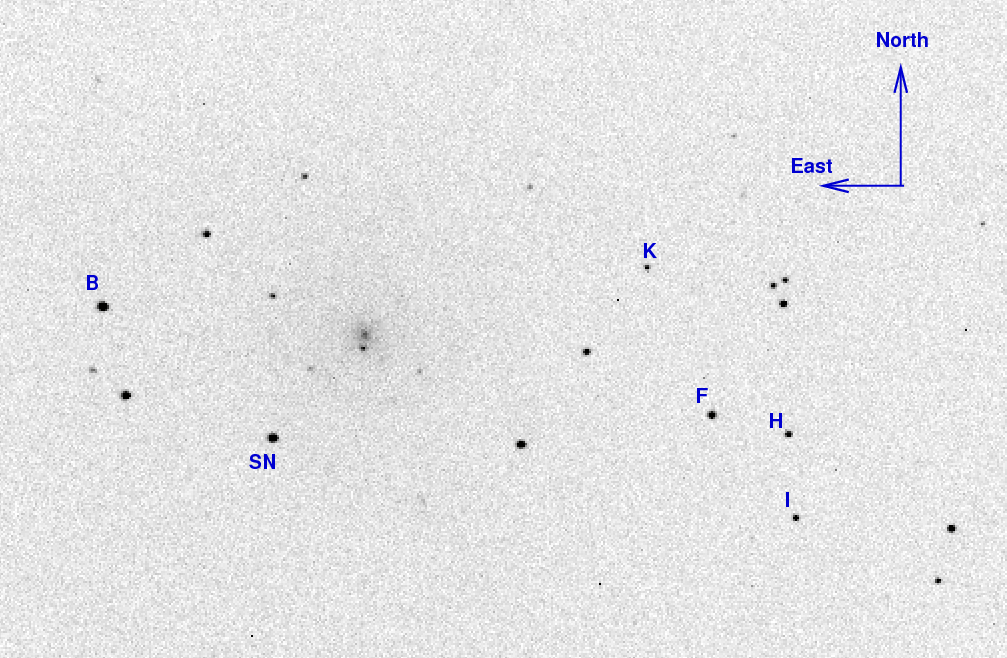
The reference stars marked above have magnitudes in AAVSO chart 12459CA, as follows:
letter B sigB V sigV R sigR I sigI B 13.012 0.019 12.510 0.019 12.154 0.019 11.834 0.019 F 13.848 0.026 13.065 0.022 12.622 0.025 12.152 0.027 H 14.338 0.029 13.692 0.024 13.329 0.029 12.964 0.030 I 14.832 0.027 13.912 0.023 13.416 0.026 12.939 0.030 K 15.192 0.034 14.613 0.027 14.275 0.034 13.915 0.036
I took 30-second guided images in VRI, but the B-band is so insensitive that, as usual, the guider couldn't hold the guide star reliably. After discarding the bad images, I was left with 7, 8, 7, and 10 images in B, V, R, and I, respectively.
Using aperture photometry with a radius of 4 pixels (radius of 7.4 arcsec), I measured the instrumental magnitudes of a number of reference stars and the target. Following the procedures outlined by Kent Honeycutt's article on inhomogeneous ensemble photometry, I used all stars available in each image to define a reference frame, and measured each star against this frame. I used the AAVSO magnitudes, plus color terms to convert the ensemble instrumental magnitudes to the standard Johnson-Cousins BVRI scale.
Results from this evening are:
filter mag mag_uncert Julian Date B = 14.109 +/- 0.085 (ens 0.050 zp 0.068) 2456533.68319 V = 13.026 +/- 0.045 (ens 0.034 zp 0.029) 2456533.67713 R = 12.574 +/- 0.023 (ens 0.022 zp 0.005) 2456533.67107 I = 12.340 +/- 0.028 (ens 0.023 zp 0.016) 2456533.66303
The uncertainties here are roughly equally distributed between extracting the instrumental magnitudes and transforming the instrumental magnitudes to the standard scale.
Grab the text file below for all the RIT measurements of SN 2013ej. All these values have been recomputed with the new color terms of UT 2013 Aug 05.
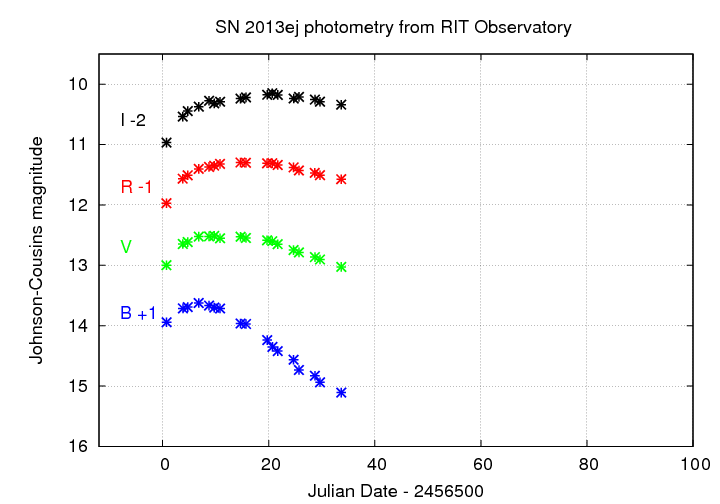
Last modified 08/29/2013 by MWR.